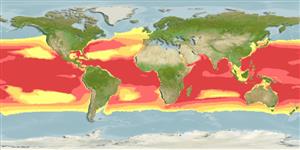Teleostei (teleosts) >
Aulopiformes (Grinners) >
Scopelarchidae (Pearleyes)
Etymology: Scopelarchoides: Greek, skopelos = a lantern fish + Greek, archos = anus + Greek, oides = similar (Ref. 45335); danae: Named after the Danish research vessel DANA used during the major expeditions of the Carlsberg Foundation, her scientific parties and crews, and the continuing work of the Carlsberg foundation that has enhanced knowledge of the deepsea fauna (Ref. 40783).
Eponymy: The succession of Danish research vessels named ‘Dana’ seem to have been greatly favoured by describers of fish, and often the etymology includes: “…from which the holotype was collected. [...] (Ref. 128868), visit book page.
Environment: milieu / climate zone / depth range / distribution range
Ecology
Marine; bathypelagic; oceanodromous (Ref. 51243); depth range 0 - 1850 m (Ref. 58018). Deep-water
Circumglobal: In tropical to subtropical waters; except Mediterranean Sea. Eastern Central Atlantic: numerous records within the area, all but one are from stations within the Gulf of Guinea (ca 5°N to 11°S and east of 15°W). Western Indian Ocean: numerous records from the Mozambique Channel and off Xai-Xai, Mozambique (Ref. 6601). Western Central Pacific: known only from 2 adult specimens, one collected from near New Caledonia and one from near the Marquesas (Ref. 40783). South China Sea (Ref.74511).
Size / Weight / Age
Maturity: Lm ? range ? - ? cm
Max length : 12.3 cm SL male/unsexed; (Ref. 13608)
Oceanic and mesopelagic (Ref. 6601, 75154). Adults have usually been taken in hauls at depths between 300 to 800 m; most larvae in hauls to depths between 0 to 200 m. Most records in all areas are from localities near continental or insular land masses. Synchronous hermaphrodites (Ref. 10755).
Life cycle and mating behavior
Maturity | Reproduction | Spawning | Eggs | Fecundity | Larvae
Johnson, R.K., 1990. Scopelarchidae. p. 393-397. In J. C. Quero, J. C. Hureau, C. Karrer, A. Post and L. Saldanha (eds.) Check-list of the fishes of the eastern tropical Atlantic (CLOFETA). JNICT, Lisbon; SEI, Paris; and UNESCO, Paris. Vol. 1. (Ref. 10755)
IUCN Red List Status (Ref. 130435: Version 2024-2)
Threat to humans
Harmless
Human uses
Fisheries: of no interest
Tools
Special reports
Download XML
Internet sources
Estimates based on models
Preferred temperature (Ref.
123201): 5.9 - 15.4, mean 9.5 °C (based on 1087 cells).
Phylogenetic diversity index (Ref.
82804): PD
50 = 0.5313 [Uniqueness, from 0.5 = low to 2.0 = high].
Bayesian length-weight: a=0.00347 (0.00143 - 0.00840), b=3.16 (2.94 - 3.38), in cm total length, based on LWR estimates for this (Sub)family-body shape (Ref.
93245).
Trophic level (Ref.
69278): 4.2 ±0.8 se; based on size and trophs of closest relatives
Fishing Vulnerability (Ref.
59153): Low vulnerability (10 of 100).
